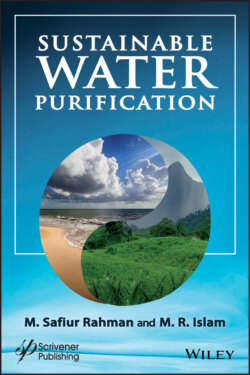Sustainable Water Purification

Реклама. ООО «ЛитРес», ИНН: 7719571260.
Оглавление
M. R. Islam. Sustainable Water Purification
Table of Contents
List of Tables
List of Illustrations
Guide
Pages
Sustainable Water Purification
Preface
1 Introduction. 1.1 Opening Remarks
1.2 Climate-Water-Food Nexus
1.3 Background
1.4 Insufficiency in Water Purification Processes
1.5 Introduction to Zero Waste Engineering
1.6 Scope of the Book
1.7 Organization and Introduction of the Chapters
Note
2 Water Science. 2.1 Introduction
2.2 Unique Features of Water
2.3 Natural State of Matter
2.4 Source of Water and Its Role in Sustaining Life
2.4.1 Inorganic Minerals
2.4.2 Organic Contaminants
2.4.3 Radioactive Minerals
2.4.4 Biological
Bacteria
Viruses
Protozoa
3Sustainability of Current Water Purification Technologies. 3.1 Introduction
3.2 Sustainability Criteria
3.3 Sustainability in the Information Age and Environmental Insult
3.3.1 Agriculture and Development
3.3.2 Desertification
3.3.3 Ecosystem Change
3.3.4 Fisheries
3.3.5 Deforestation
3.3.6 Marine Litter
3.3.7 Water Resources
3.4 Biological Processes
3.4.1 Sulfate Reducing Bacteria
3.5 Chemical Precipitation
3.6 Membrane Separation
3.6.1 Microfiltration
3.6.2 Ultrafiltration
3.6.3 Nanofiltration
3.6.4 Reverse Osmosis
3.7 Ion Exchange
3.8 Ozonation
3.9 UV Radiation
Advantages:
3.10 Adsorption
3.10.1 Existing Sorbents
3.10.2 Agricultural Waste
3.10.3 Industrial By-Products
3.10.4 Natural Materials
Note
4 Sustainable Drinking Water Purification Techniques. 4.1 Introduction
4.2 Natural Lifestyle
4.2.1 Environmental Awareness
4.2.2 Corporatization and Healthcare
4.2.3 Death and Lifestyle
4.2.4 Role of Water in Bodily Functions
4.2.5 A Relevant Anecdote
4.3 Natural Minerals
4.3.1 Filters
4.3.2 Ground Water Recharge
4.3.3 Aeration
4.3.4 Brick, Clay and Others
4.4 Solar UV Treatment
4.5 Natural Ozonation
5 Sustainable Purification Techniques for Agricultural Waters. 5.1 Introduction
5.2 Organic vs. Chemical Agricultural Practices
5.2.1 Denaturing for a Profit
5.2.2 The Consequences
5.2.3 The Sugar Culture and Beyond
5.3 Removal of Heavy Metals
5.3.1 Application of Wood Sawdust for Removal of Heavy Metals
5.3.1.1 Composition, Structure and Morphology of Wood
5.3.1.2 Structure and Morphology of Wood
5.3.1.3 Removal of Heavy Metals Using Wood Saw Dust
A. Langmuir isotherm
B. Freundlich isotherm
5.3.1.4 Conclusion
5.4 Removal of Heavy Metals Using Fish Scale
5.4.1 Fish Scale Collection and Treatment
5.4.2 Experimental Setup and Procedure. 5.4.2.1 Static Method
5.4.2.1.1 Effect of Time
5.4.2.1.2 Effect of Environmental pH
5.4.2.2 Dynamic Method
5.4.3 Conclusions
5.5 Solar UV Treatment
5.5.1 Effects of UV-Radiation
5.5.2 Effects of Temperature (Infrared Radiation)
5.5.3 Advantages of Solar Water Disinfection (SoDis)
5.5.4 Limitations of Solar Water Disinfection
5.6 Bioremediation for Sustainable Purification of Water
Notes
6 Sustainable Purification Techniques for Industrial Wastes. 6.1 Removal of Radionuclides
6.2 Removal of Heavy Metals Precious Metals
6.2.1 Precious Metals and Heavy Metals Recovery
6.3 Industry Lifestyle Change
6.3.1 Mercury
6.3.2 Sal Ammoniac
6.3.3 Sulphur
6.3.4 Arsenic Sulphide
6.3.5 Refining Techniques
6.4 The Energy/Water Crisis
6.4.1 Are Natural Resources Finite and Human Needs Infinite?
6.4.2 The Finite/Infinite Conundrum
6.5 Certain Sustainable Technologies. 6.5.1 Direct Use of Solar Energy
6.5.2 Effective Separation of Solid from Liquid
6.5.3 Effective Separation of Liquid from Liquid
6.5.4 Agricultural Waste for Water Purification and Value Addition
6.5.4.1 Orange Peel
6.5.4.2 Pomelo Peel
6.5.4.3 Grapefruit Peel
6.5.4.4 Lemon Peel
6.5.4.5 Banana Peel
6.5.4.6 Cassava Peel
6.5.4.7 Jackfruit Peel
6.5.4.8 Pomegranate Peel
6.5.4.9 Garlic Peel
6.5.5 A Novel Desalination Technique
6.5.6 A Novel Separation Technique
Notes
7Summary and Conclusions. 7.1 Summary
7.2 Conclusions
7.2.1 Chapter 1: Introduction
7.2.2 Chapter 2: Water Science
7.2.3 Chapter 3: Sustainability of Current Water Purification Techniques
7.2.4 Chapter 4: Sustainable Drinking Water Purification Techniques
7.2.5 Chapter 5: Sustainable Purification Techniques for Agricultural Wastes
7.2.6 Chapter 6: Sustainable Purification Techniques for Industrial Wastes
References and Bibliography
Index
WILEY END USER LICENSE AGREEMENT
Отрывок из книги
Scrivener Publishing 100 Cummings Center, Suite 541J Beverly, MA 01915-6106
.....
Water is a transparent, tasteless, odorless, and nearly colorless chemical substance, which is the main constituent of Earth’s hydrosphere, and the fluids of most living organisms. It is vital for all known forms of life, even though it provides no calorie organic nutrients. Its chemical formula is H2O, meaning that each of its molecules contains one oxygen and two hydrogen atoms, connected by covalent bonds. Water is the name of the liquid state of H2O at standard ambient temperature and pressure. It forms precipitation in the form of rain and aerosols in the form of fog. Clouds are formed from suspended droplets of water and ice, its solid state. When finely divided, crystalline ice may precipitate in the form of snow. The gaseous state of water is steam or water vapor. Water moves continually through the water cycle of evaporation, transpiration (evapotranspiration), condensation, precipitation, and runoff, usually reaching the sea. The distribution of water on the Earth’s surface is extremely uneven. Only 3% of water on the surface is fresh; the remaining 97% resides in the ocean. Of freshwater, 69% resides in glaciers, 30% underground, and less than 1% is located in lakes, rivers, and swamps. Looked at another way, only one percent of the water on the Earth’s surface is usable by humans, and 99% of the usable quantity is situated underground.
Due to different types of natural and anthropogenic activities surface and ground water become contaminated. Water pollution by toxic pollutions (inorganic and organic) has become a subject of interest especially since the establishment of the EPA (Environmental Protection Agency) in 1970. The problem of water quality degradation of both surface and sub-surface streams has been evident for a long time. Achieving an acceptable quality of surface water focuses on reducing emissions of known pollutants to within safe industrial and drinking standards. In developing nations, many of today’s industrial projects are environmentally hostile.
.....